Happy Holidays!
Happy Holidays from Makeagingwork.com



Photo by Tim Cooper on Unsplash
I recently answered this question for an obvious younger whippersnapper on Quora.com.
With the 20th anniversary of that age within view for me, I had a few thoughts I’ve accumulated over those two decades.
I hope you won’t expect much more than a cake with a lot of candles on that day, along with a whole bunch of unfunny ageist birthday cards, and a nauseating rash of “over the hill” comments from so-called friends. For example:
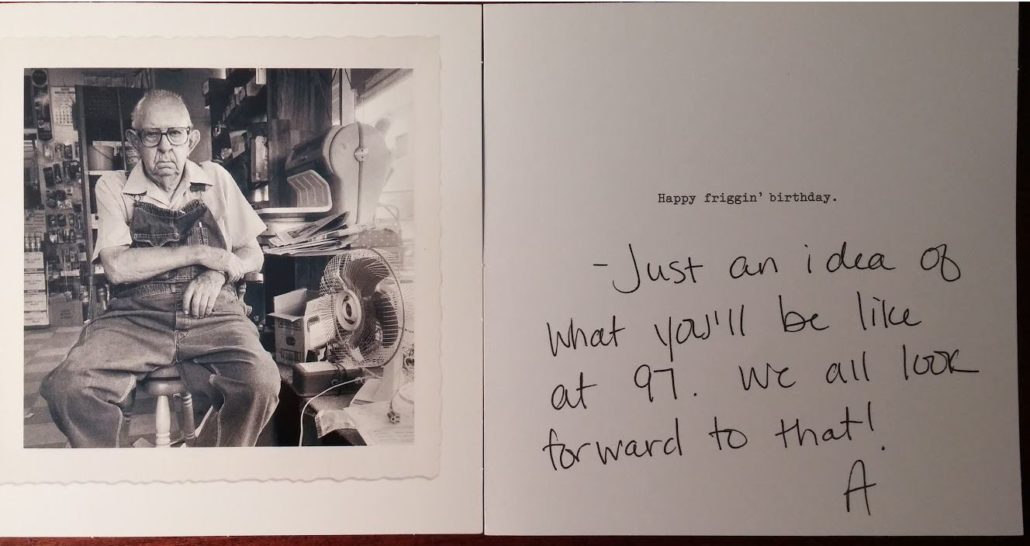
Birthday card from my daughter
Most people get there. How is it more significant than say 50 or 65?
Or any age, for that matter.
As they say, it’s just a number.
Things didn’t start falling off 20 years ago when I turned 60. I was still playing pickup basketball and lifting weights 5x a week. I had to give up the BB at 63 because of a knee issue but still lift weights aggressively 3x per week.
I did notice a slight reversal at or around that time – nose running and feet smelling (sorry – old bad joke!).
I went against the grain and decided to leave corporate life and start my own business. The idea of retirement didn’t appeal to me then and still doesn’t.
I had grown accustomed to being told that I looked and acted much younger than my 60 years. My response was then – and still is today – that it’s not an accident or genetics. I work at it, physically and mentally. Then and today.
If I tie how I feel or expect to look to a number, I have the wrong mindset. Based on my number and the current average life span of the American male (78.6), well – I missed my funeral.
I am so mystified and miffed at the strange hold that the number 60 and 65 have on us in the U.S. It’s an artificial finish line, an arbitrary number with no particular significance other than the tag the government tied to it 86 years ago and the number the financial service industry keys off of as they help you plan for your demise.
The crest of the hill? The start of the downward slide?
Really? Let’s give it a break and not assign any particular significance to a number, least of all this one.
Willam Shatner didn’t. Do you see what he’s doing at age 90? Or Warren Buffet? Or Clint “The Mole” Eastwood? Betty White will become a centenarian in a few months. It’s a long list of folks who blew past 60, then 65, and didn’t tag any significance to it. Maybe that’s why they’ve been so successful.
Just one big thing.
I’d have a better handle on my essence.
Eeew!! That sounds so esoteric, new agey.
But it’s true. I cut the cord and stepped into the entrepreneurial world totally unequipped and for the wrong reasons. Three decades of corporate life had done nothing to equip me to start my own business. I had never encountered the type of mental challenges that come with putting it on the line with your own business.
I bailed from corporate to have more freedom, to get away from the lack of control of my time and my schedule, and, from self-centered, ladder-climbing bosses. And I bought the Koolaid that said starting your own business in the new world of the internet (yes, it was a baby back then) was going to be easier and more profitable than ever. The work-from-home, control-my-time, t-shirts-and-shorts-wardrobe dream was very alluring.
What I didn’t do was to fully understand what I was really good at and what I wasn’t so good at.
It took me over a decade, a big bunch of stumbles, and an embarrassing slice of a healthy “retirement savings” to come face to face with the fact that I was – and had been for nearly 40 years – operating outside of how my maker had really wired me up and equipped me.
We buy into the 20th-century linear life model of learn-earn-retire and end up with a life spending 40 years busting the hump for what?
FTM – For The Money
-and that nirvanic pot of gold at the end (around 60) called retirement, that unnatural concept that doesn’t exist in nature, didn’t exist anywhere on the planet 150 years ago, was conceived for political purposes, and takes us away from how our biology serves us.
At 60 or thereabouts, a fork in the road appears. Start the downward slide or relaunch. Is the rest of your life going to be another and different type of takeoff – or a landing?
Your mind and body are not ready for a landing – they don’t want a landing. They are built to last 122 years and 164 days because a lady in Paris set that benchmark for us in 1997. Reaching 60 isn’t even halfway to that biological benchmark. Yet we cash out at an average age of 80 – only 65% of our full-life potential.
Perhaps much of that is due to the mindset and the decisions that we make at or around age 60.
If you’ve checked, you know that we are living longer than previous generations – maybe by as much as 20, 30, 40 years. Turning 60 and facing another 30 years changes the narrative that we’ve lived with for the last 50 years that says you’re done being anything other than a consumer at 60 or 65.
Be a producer, not a consumer. Forget the self-indulgence.
We’re led to believe that we’re “entitled” to a life of leisure in our later years, that we’ve paid the price to “the man” and earned the right to be a self-indulgent and selfish consumer.
There’s a risk in all that because it doesn’t serve our biology well.
Pre- and early-retirees list these as their greatest fears:
So, at 60, expect your surrounding culture to put certain expectations on you, all based on outdated, irrelevant narratives.
Your choice then becomes buying in or going against the grain. At 60, chances are high that you’ve got lots of gas left in the tank. Resist the pressure and temptation to start the withdrawal and your biology will reward you accordingly.
Consider the possibilities of leveraging decades of acquired skills, experiences, and wisdom to do something the world needs and that is aligned with your innate talents.
I love – and have adopted – a credo followed by Dr. Ken Dychtwald, gerontologist and the world’s foremost authority on aging, that he unveils in his autobiographical book, “Radical Curiosity.”
At 60 and beyond, you are ideally equipped to do just that.
60 yet? We’d love to hear what it was like for you and what followed. Leave a comment or shoot an email to gary@makeagingwork.com.

Yes, life does go downhill, but –
-we have some choices in the matter.
Not with the eventuality of it, but with the starting point and the pace.
The reality is, we took out a death certificate at birth. Or, as retired Stanford geriatric physician, Dr. Walter Bortz once wrote:
“Life is a fatal disease. Once contracted, there is no known cure.”
Our brains will have matured by our early- to mid-twenties. We grow to physical and reproductive peaks in our late twenties. From that point, the gradual, eventual decline begins. Unnoticeable at first, but commencing insidiously and at a pace determined to a significant degree by-

-the lifestyle choices we make in these early years.
Graph A:

Graph B:
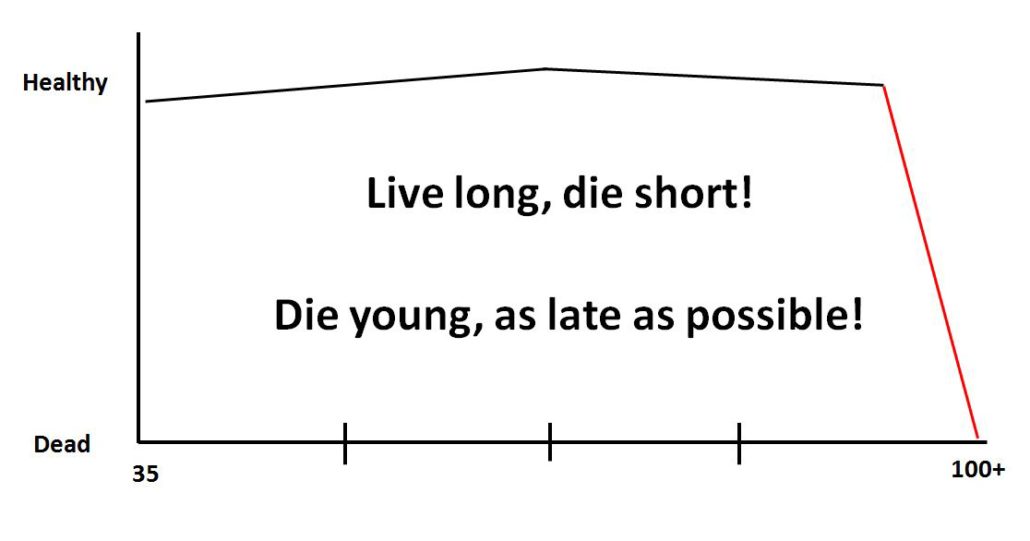
Notwithstanding the rare chance that a person has blue-print errors (genetic defects) at birth, Graph A is, unfortunately, what the life curve becomes for most people across the average lifespan: a peak at mid-life followed by an accelerating downslope, often undetected at first and too often ignored when detected.
The start of this downslope and its severity is impacted significantly by the choices made earlier in life.
The pace and severity of the slope are also impacted by the choices made at mid-life and beyond.
(My thanks to Exercise Physiologist Dan Zeman for this analogy)
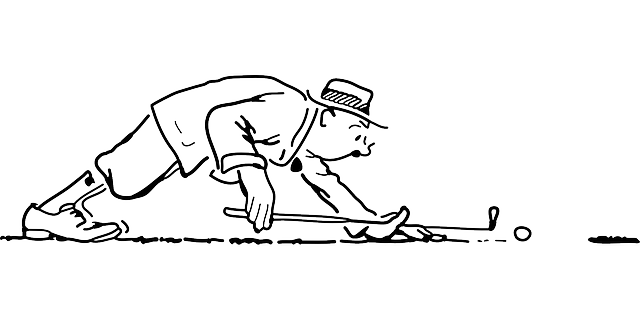
The choices made – for example, diet, exercise, stress relief – during the Front Nine lay the foundation for what the Back Nine may look like and what will need to be done to offset the poor choices in the Front Nine.
Continuing the analogy, one could say that age 40 (against the prevailing average lifespan of 80) represents the completion of the Front Nine.
If one starts the Back Nine overweight, sedentary, consuming the Standard American Diet (SAD), and living in a high-stress environment, the work that will need to be done to slow the acceleration of the aging process – that is, to recover – on the Back Nine, can be a challenge.
Professional golfers are knowledgeable enough about their game to sometimes be able to make corrections “at the turn” and recover from a disastrous front nine – perhaps a tweak to the grip, swing tempo, attitude adjustment, listening to their caddy, etc.
For those of us enmeshed in the typical western lifestyle, that type of Back Nine adjustment isn’t so easy because –
-we don’t know how our biology works!
Unlike a pro golfer, most of us enter the Back Nine naive to the “tweaks” that it will take to overcome the Front Nine mishits.
In our comfort, convenience, and comparison-driven western culture, we have little understanding or appreciation for what we do and don’t do to our biologies as we chase our dreams, climb our ladders, keep up with the Joneses.
The result is often a compounding of bad choices which we don’t fully understand to be bad choices until they start manifesting at or around middle age.
For instance-
-over 60% of the American male population is overweight, 25% are obese.

We weigh, on average, 15 pounds more than 20 years ago but we didn’t get any taller, just a lot rounder.
Lifestyle diseases – heart disease, cancer, stroke, diabetes, dementia – continue to increase as the major killers in western culture.
What changed about our biology that would cause that?
NOTHING. But our choices became less supportive of what our biologies need to function optimally over the long term.
We hit 40, 45, 50 and our biological life begins to morph, the degree of which depends on how we honored our birthright of good health in the preceding decades.
Here’s the reality.
In America, we are embarrassingly behind most other developed countries in the length of time that our elderly live in poor health and on our average life expectancy.
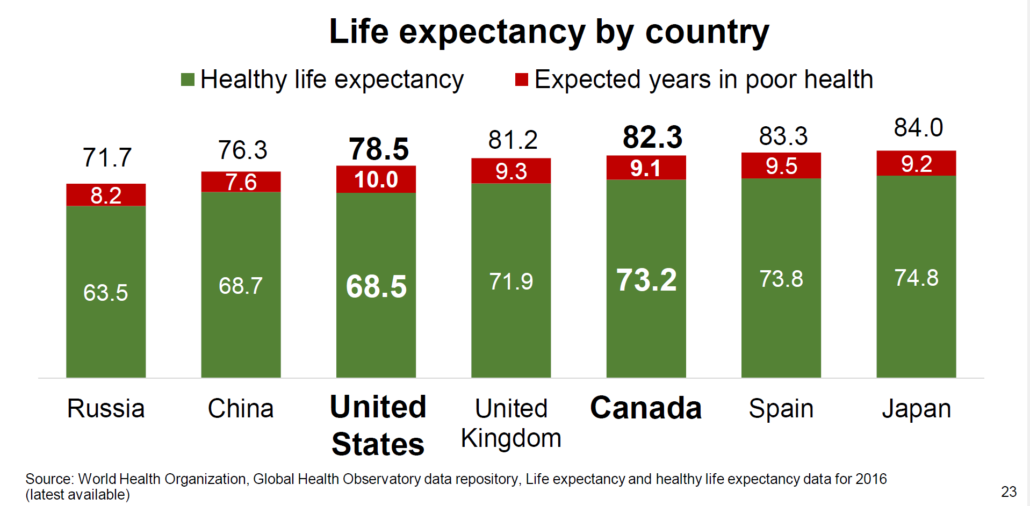
Lifestyle choices, before and after mid-life, play a big role in that statistic.
Yes – or something closer to it than Graph A.
It’s never too late to start but always too early to quit.
Our bodies have amazing recuperative powers. Our collection of 35 trillion cells have been miraculously kludged together into an incredible immune system working 24/7 to fend off nefarious invaders and keep us healthy.
Yet, we ignore and abuse that system in our ignorance of what those simple cells need to do their job.
Once we understand what they need to function optimally and then act on that knowledge, we are on a track to salvage the Back Nine and Live Long and Die Short.
I’m about to step into my ninth decade (for Kansas City Chief fans, that means I soon turn 80 years old).
Statistically, as an American male, I’m late for my funeral.
I grew up in the 1950s and can lay claim to a pretty crappy front nine. I smoked until age 37. My athletic/physical activities ceased after high school. My diet into my 50s was the SAD.
The lights began to come on June 6, 1979, when I quit smoking and began a slow progression into a lifestyle that remains today one of high levels of aerobic and anaerobic exercise, a departure from SAD and toward a more plant-based diet, and a commitment to avoiding traditional retirement.
I continue to work at what I’m good at and what I enjoy with the awareness that work is a key component of healthy longevity.
Graph B is my goal and my lifestyle choices are aimed at that with an endpoint that exceeds 100 years.
I know it could be over tomorrow. My “right” choices started a little late to expect to get past 100. But, given the choice, I’m going for it rather than to accept the average, which I’ve already surpassed.
Avoid the accelerators.
In western culture, we face more “age accelerators” than ever in history. It’s evidenced by the fact that, after 120 years of meteoric improvement, our average lifespans in American have been declining for the last several years.
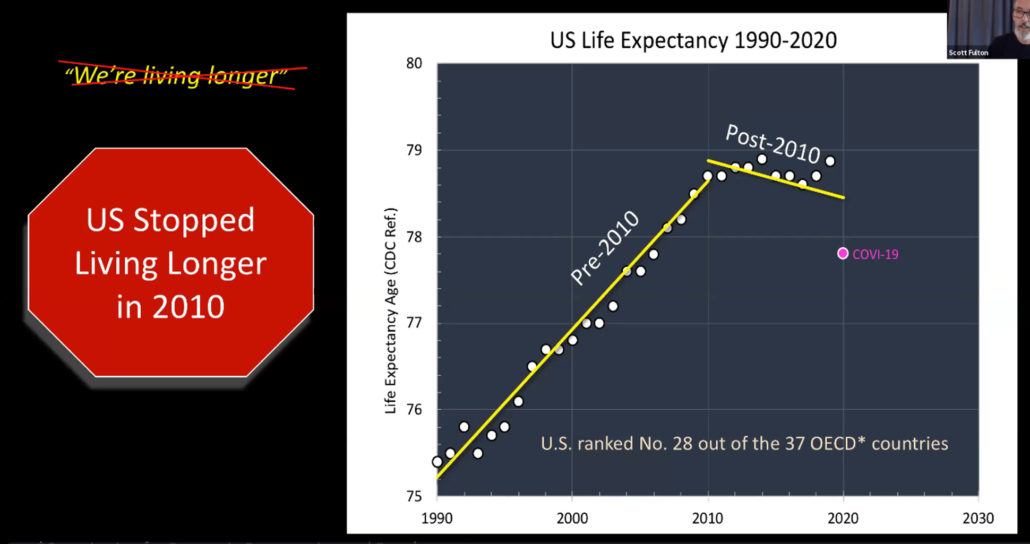
Source: Scott Fulton
Despite all the scientific and biomedical knowledge we’ve gained, we continue to choose to make bad lifestyle decisions in our pursuit of comfort and convenience and because we “compete to compare.”
We receive no help from a healthcare system that only knows cure and not prevention and a food industry that doesn’t give a rip about our health.
We’re on our own to make better choices based on knowledge.
Here’s an article that may help you make better choices and avoid the more common aging accelerators:
https://makeagingwork.com/2018/04/16/the-dirty-dozen-of-accelerated-aging/
Graph B comes from the life-changing book “Younger Next Year: Live Strong, Fit, and Sexy – Until You’re 80 and Beyond.” (paid link)
Make reading it one of your choices.
And adopt the appendix, entitled Harry’s Rules, written by co-author Dr. Henry Lodge:
Harry’s Rules
Seven clear choices to avoid the downhill.
D0 you have a plan to enact Graph B. We’d love to hear about it. Leave us a comment below.

I wish it happened more often. You’d think they would for someone who spends as much time thinking and trying to unravel the mess that constantly swirls between my temples.
A few dots connected this week after I read another Julia Hubbel article entitled “Are You in Training for Old Age? Or Just Planning to be Elderly?” and then a Bloomberg Opinion article in our local newspaper that my bride alerted me to entitled “Counting calories helps your retirement account.”
My thoughts then rolled to the concept of a 25-year life plan espoused by Dan Sullivan, founder of Strategic Coach and one of the foremost executive coaches on the planet.
Julia is way outside the bell curve in most things, but particularly in the area of fitness.

Schlepping wood. Julia Hubbel
At 69, she’s recovering from shoulder surgery which is part of her preparation for her “training to summit Kilimanjaro for the second time the year I turn 70, ten years to the day after I did it at sixty.”
I don’t ‘spect many of you out there have Kili on your bucket list. I certainly don’t.
So, why on earth?
Let me excerpt from her post to make her point (bolding is mine):
“You and I set ourselves up for Early-onset Elderly when we take lousy care of the skinsuit we’re in. Ultra-processed food, no exercise, and lots of ugly self-talk about how old you feel.
I’m in training for my eighties and beyond. I fully expect to be active, engaged, athletic and joyful. I have no time or patience for being elderly, which is a state of mind.
Is it time for you to set a BHAG (Big Hairy Ass Goal)? No matter how old you are, there’s always time to point at something high, aim, and put in the effort. You never know where it might take you.”
Speaking of BHAGs – –
-Dan Sullivan, the founder of Strategic Coach, has his own version, which he has followed and taught for most of his 40+ years of coaching over 8,000 successful entrepreneurs.
He keeps a rolling 25-year life plan out in front of him – a long game with a motivating, evolving stretch goal always a quarter-century out, regardless of age.
His theory is fundamentally sound. If we set a worthwhile, challenging, and achievable goal, our brain, being a teleological device, will help us get there.
Dan is pretty deep into his 70s which makes his dedication to this plan seem illogical. But, it underscores the fact that goal setting is age-independent.
The execution of Dan’s plan is where the power and beauty lie. He works backward from the 25-year goal to the current quarter, defines the five things he needs to do that quarter toward that 25-year goal, and then back further to the three things he will do TODAY against those five quarterly goals.
Taking them one at a time, his day is done when those three things are complete, whether it takes an hour or 20 hours.
It’s a beautiful plan for present moment focus that allows one’s brain to work for and not against as it is so inclined to do with fears and regrets as we age.
As an outspoken believer in living well past 100, Dan has been planning for old age most of his life.
Chew on this:
“A 55-year-old woman with Type 2 diabetes will pay an average of $3,470 more a year in medical-related expenses, or close to $160,000 in total, than if she didn’t have the disease.”
So says the Bloomberg Opinion article 11/28/2021, making the point that “the right food choices over time can have just as much of an impact on retirement savings as market forces and investment decisions.”
The article goes on to emphasize that few retirement planners focus on diet or other lifestyle changes that can help avoid chronic conditions that erode savings.
Medical professionals rarely talk about financial issues related to poor health, let alone any kind of plan. That doesn’t roll up under the prevailing “drug it or cut it out” medical model we inherited.
Both are sadly deficient in helping plan for old age.
Both are content to let becoming elderly be the plan.
Whether you are 50, 60, 70 or beyond, retired or not retired, setting goals still makes sense.
Maybe this will help re-inspire you to keep planning.
Let’s reintroduce the Retirement Planning Wheel. Use it to do an honest assessment of where you are today in each of these 12 areas of your life.
How balanced is your wheel?
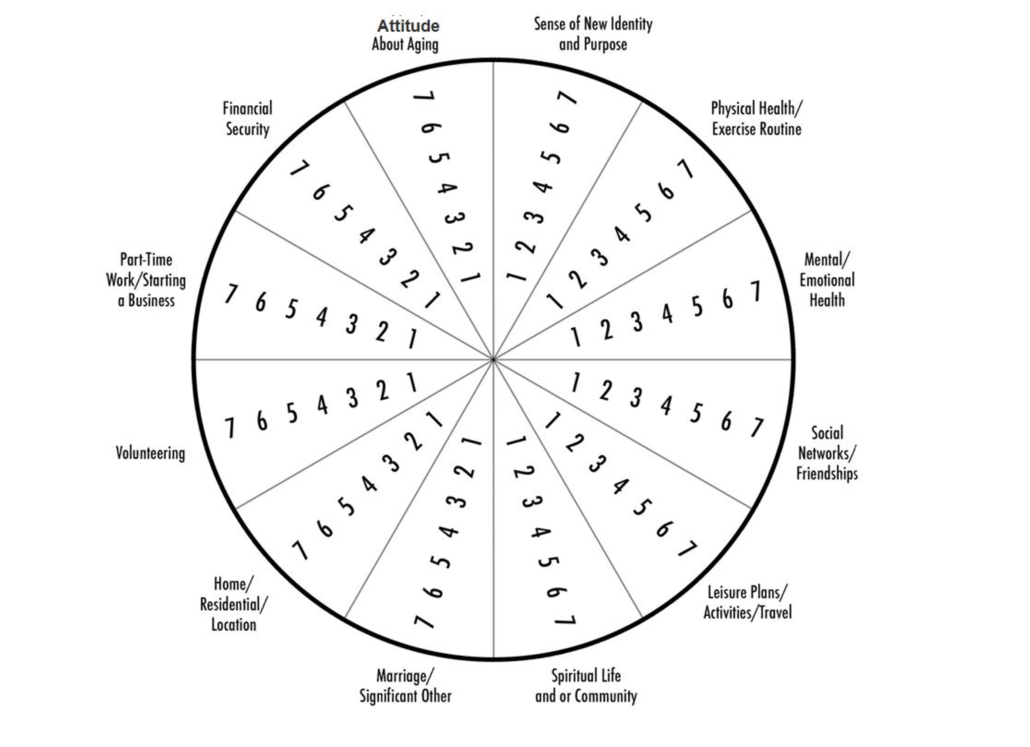
Then set a goal in those areas that you feel are out of balance. A weekly goal, an annual goal, and OK – maybe even a 25-year goal.
I’ll let Julia wrap this with a line from her article:
“When life happens, you and I have to happen to life. We can wail woe is me, or we can choose to climb aboard another goal and get going.”
In hopes that I’ve connected some dots, I’m leaving for 24 Hour Fitness. Mondays are 40 minutes of machine circuit and 30 minutes of aerobic with some H-I-I-T.
-but it’s part of the 25-year plan, I like the results and –
-if I don’t move my body, I can’t really suggest that you move yours.
Is there a 1,3,5,10, or 25-year plan in your head? Let us know what you think about all this. You can leave a comment below or email us with your thoughts at gary@makeagingwork.com.

“Worrying about getting old makes us old. Being terrified of aging ages us perhaps more swiftly than anything. Research shows time and time again that our attitudes about how we age have a huge influence on how we age. When we constantly complain about how old we feel, how decrepit we are, we bring those truths into being. We stoop, slow down, give up, and talk ourselves into an early grave.”
That’s a quote from a recent article written by Julia Hubbell, a prolific and talented writer and 68-year-old self-proclaimed “bad-a**” who lives life continuously messing around at, or just beyond, the far edges of her mental and physical comfort zone. I’ve followed her on Medium.com for a couple of years, from when she was a fellow Coloradoan to now as she’s “escaped” to Oregon.
I guess I enjoy her edgy writing style because she doesn’t suffer fools, sorts out truth better than most people I know, and isn’t afraid to deliver a gut punch.
Hence, this article caught my eye: Terrified of Deteriorating and Dying Young? How to Avoid Early-Onset Elderly
Julia references a study of Princeton students that found that “the students, by and large, clung to common stereotypes about the elderly, most notably those pertaining to the elderly being incompetent and less ambitious. Although their findings were mixed in regard to general discrimination and prejudice toward the elderly (e.g., both positive and negative feelings were present), they found that although most students felt a sense of warmth toward the elderly the most common sentiment involved feelings of pity toward them.“
Sorry, but I don’t think “sense of warmth” is an adequate offset to pity.
Pity gets my 80-year old hackles up!
Just don’t, please.
I don’t know if Julia originated the term “early-onset elderly” (I’ll give her credit for it) but I’m stealing it. Writers do that a lot.
It’s a perfect description of a self-inflicted condition that is still way too prevalent in our culture.
We of advancing age are often guilty of bringing on the ageism we are so quick to condemn.

We can point at our youth-oriented society, media, advertising agencies, the entertainment industry, and legitimately claim that we’re up against formidable forces to gain respect. But we mustn’t forget that when we point, we have three digits pointed back at us.
Given that, then what are three things that we overlook that contribute to making it easy for our youngers to drag out the pitying attitude.
1. Our physical appearance.
There’s nothing that says “geezer” or “biddy” more clearly than bad clothes hanging on a body that has been allowed to deteriorate. And nothing sets one apart amongst our demographic better than a fit body appropriately attired with clothes that are properly fitted and fashionably current.
One of the physical traits that become prevalent as we age is poor posture. Our age group tends to become “commas” instead of “exclamation points.” Stooped shoulders, slouching – traits that belay our age. But these are traits that are addressable.
We weren’t born with poor posture – we’ve trained ourselves into it. And we have to work hard to get our good posture back.
Dr. Walter Bortz, in his book “Dare To Be 100” puts it into a good perspective:
“Some of the bad news about aging derives simply from the way many older people look. They look bent and spent. Their posture seems to tell the story of their lives, as drooping slowly to the grave. Or course, almost all of this is preventable, and much of it is reversible. The dowager hump comes from decades of conceding to gravity – and just plain laziness. You have to work hard to have good posture.”
2. Our isolation and failure to engage.
We don’t disengage because we are old. We become old because we disengage.
Fifty years ago, disengagement was the dominant theory of the psychology of aging. Aging people were expected to loosen their bonds with society, falling away from the environment and the environment falling away from them.
Retirement and other social cues and institutional practices still come into play that pull us away from engagement with those younger. We isolate and escape to “elder warehouses” where we congregate, commiserate, and commune with only those like us, failing to engage those younger.
Younger people aren’t going to seek us ought. It’s on us to be proactive in engaging younger people, share our wisdom, listen to their concerns, and learn from them.
3. Our rigid thinking.
Are we listening to the concerns that the 2-3 generations behind us are expressing? Do we demonstrate “I’ve got mine, so don’t bother me with your whining about climate change, planet destruction, income inequality, unaffordable housing, et.al.?
We pre-boomer, boomers, early GenXers have been pretty harsh on the late GenXer, millennials, Gen Y’s.
It’s time we listen and be open-minded.

Photo by call me hangry on Unsplash
What’s your reaction when you look at this picture?
My reaction? I’m like a Pavlov dog – I start salivating. Put a brat with mustard on a white bun within a city block of me and I’m off my heath-and-wellness rails in a heartbeat in my clamor to indulge – and I can’t stop at one.
Hey, I’m a health and wellness advocate with an above-average awareness of the ills embedded in our profit-driven food system and an understanding of the long-term ill effects of eating garbage.
OK – yeah! I’m a weak hypocrite!
That picture above, folks, can be found right next to Webster’s definition of garbage in the dictionary. It’s typical of the garbage that props up the shareholder value of the giants of our presumably benevolent food industry.
What’s happening here?
Aside from my inherent lack of self-discipline, a collection of cells at the back of my tongue were captured and kept captive years ago as I innocently, naively allowed creative food engineers to seize my taste buds with scientifically-crafted, addictive combinations of fat, salt, and sugar.
You’ve probably come across the media announcement that consuming a hot dog takes 36 minutes off your life.
Bummer! There’s goes my goal to hit 112 1/2.
I luv hot dogs!
Especially Home Depot hot dogs.
I went through a multiyear spell of finding any excuse – legit or lame – to visit Home Depot. Often multiple times a week.
You should see my collection of screws and mollies.
Every trip ended with two mustard-lathered hot dogs from the street vendor they allowed at one of the main exits.
They were cheap – $1.50 each. Just good ‘ol plain Hormel tubes of you-don’t-want-to-know ingredients generously injected with salt.
My captive taste buds overrode any semblance of knowledge and common sense!!
Each trip = over an hour off my life.
What are we to do to protect weaklings like me from ourselves?
Why, of course, we call in the politicians. Let’s sic Congress on this one also.
It appears that Senator Cory Booker believes so. I quote the distinguished Senator from a recent article in MedPage Today:
“Currently in the United States, half of the U.S. population is pre-diabetic, or has type 2 diabetes. In 1960, approximately 3% of the U.S. population was obese. Today, more than 40% of Americans are obese and more than 70% of Americans are either obese or overweight.”
“–now we face that second food crisis — one of nutrition insecurity where too many Americans are overfed but undernourished and are seeing these staggering rates of disease and early death.” Although the U.S. is the world’s wealthiest nation, “we have created a food system that relentlessly encourages the overeating of empty calories, literally making us sick and causing us to spend an ever-increasing amount of our taxpayer dollars … on healthcare costs to treat diet-related diseases such as type 2 diabetes, heart disease, stroke, certain types of cancer, and chronic kidney disease.”
Don’t you love it – this bandwagon game?
And we wonder why Congress has a 27% approval rating.
Excuse me, Senator, but how long have we known all this? How long have legions of respected physicians and nutritionists been beating this drum?
How long has our government been issuing unhealthy nutritional guidelines that are heavily influenced by the same food industry that is killing us slowly?
Oh, maybe like nearly forever – or at least a couple of decades.
But that doesn’t deter any able politician from jumping on another band wagon even when the wagon is really late.
Simple – slap a fancy name on the issue, call it nutrition insecurity, and rage against the machine – a machine that fakes its concern about our health and nutrition and rakes in billions by exploiting our biological affinity for sugar, salt, and fat and our bent toward comfort and convenience.
We did effect major behavioral change through government action driving smoking cessation.
But, not everybody smoked.
Everybody eats.
Picture warning labels on every Big Mac or bag of fries. Or Big Gulp. Or Hormel hot dog or Johnsonville brat.
Just suppose we started teaching physicians how and why to write prescriptions for beans, broccoli, bananas, and blueberries.
Can you imagine?
Your Primary Care Physician looking up your nose, in your ears, tapping your knees for reflex, doing the deep breaths and the “turn your head and cough” and the rubber glove digital exam thing (sorry ladies – I can’t speak to your physicals – I haven’t been allowed in the room when in progress) then looking up from his computer (if you are lucky) and writing a prescription to fill at your local super market.
No, not at the pharmacy or the middle aisles – along the perimeter in the produce section.
“Here”, he or she says, “fill this list and take several days a week – for the rest of your life. No, your insurance won’t cover the beans, brocolli, bananas, blueberries. But, there’s a good chance you won’t be needing insurance much if you take this prescription as directed.”
Suppose, instead of trying to legislate behavior change, we legislate change at the medical school level and require nutritional training that forces doctors to be honest about their oath to “do no harm” by being proactive in counseling patients on proper diet and the consequences of a poor diet.
I wrote about this a few months back (see the article here) and included a video by one of the greatest champions of good nutrition, Dr. Michael Greber, that documents the shortfall in nutritional training in our medical schools.
It’s an outrage.
This could be a culture change that could beget another – and huge – culture change.
Maybe you are lucky and have connected with a physician who is nutrition savvy and proactive in nutrition counseling.
They are out there – and growing in numbers, slowly.
But, we need to find a way to increase the numbers faster – fast enough to prevent the Cory Bookers from grabbing the spotlight and sending the issue into neverland.
What are your thoughts on this? Anybody have a magic formula for retraining taste buds? Leave a comment below and tell your friends to join the tribe/diatribe at www.makeagingwork.com.

Well, I screwed up.
This week’s post is going out next week. I hit the wrong send button in Mailchimp at midnight last night, obviously in a fog from a long day.
So, I’m filling in this week with a funny (as opposed to the usual run of unfunny stuff you are so kind to read).
I just wrapped up a season of golf playing in a senior men’s golf league. This is a seriously geratric league and, on Wednesday mornings, is the largest concentration of artificial knees, hips, and 55″ waistlines in the Denver metro area.

Good group of guys. No serious golf prowess is demonstrated between 7 a.m. and noon on league day.
I’m a poster child for poor golf. Despite playing over 30 rounds this summer, practicing a couple days a week, I didn’t move my handicap one iota.
Clubs are in timeout – and I’ve got my Wednesday’s back.
I’m admonished by my wife (and some friends) for being too serious about wanting to get better.
You know, the bit about “just enjoying nature and being in the outdoors.” To which I say, if that’s your thing, try bird watching.
Golf is intentionally designed to weed out the bird watchers and drag in guys like me with the ridiculous notion that they can get really good at the game.
I remain undettered in my commitment to shoot my age. I know it’s achievable but it means I will still need to be able to swing the club at age 100 because that’s where my score has been stuck for years now.
So, as a goodbye to the golf season and to fill in for my posting mess-up, I’m sharing this collection of exchanges that have been detected between golfer and caddy.
Enjoy. I don’t think you have to be a golfer to laugh a little at this.
Number:10
Golfer: “I think I’m going to drown myself in the lake.”
Caddy: “Think you can keep your head down that long?”
Number: 9
Golfer: “I’d move heaven and earth to break 100 on this course.”
Caddy: “Try heaven, you’ve already moved most of the earth.”
Number: 8
Golfer: “Do you think my game is improving?”
Caddy: “Yes . . . You miss the ball much closer now.”
Number: 7
Golfer: “Do you think I can get there with a 5 iron?”
Caddy: “Eventually.”
Number: 6
Golfer: “You’ve got to be the worst caddy in the world.”
Caddy: “I don’t think so . . .that would be too much of a coincidence.”
Number: 5
Golfer: “Please stop checking your watch all the time. It’s too much of a distraction.”
Caddy: “It’s not a watch – it’s a compass.”
Number: 4
Golfer: “How do you like my game?”
Caddy: “It’s very good – personally, I prefer golf.”
Number : 3
Golfer: “Do you think it’s a sin to play on Sunday?
Caddy: “The way you play, it’s a sin on any day.”
Number: 2
Golfer: “This is the worst course I’ve ever played on.”
Caddy: “This isn’t the golf course. We left that an hour ago.”
And the Number: 1 . . . . Best Caddy Comment:
Golfer: “That can’t be my ball, it’s too old.”
Caddy: “It’s been a long time since we teed off, sir.”
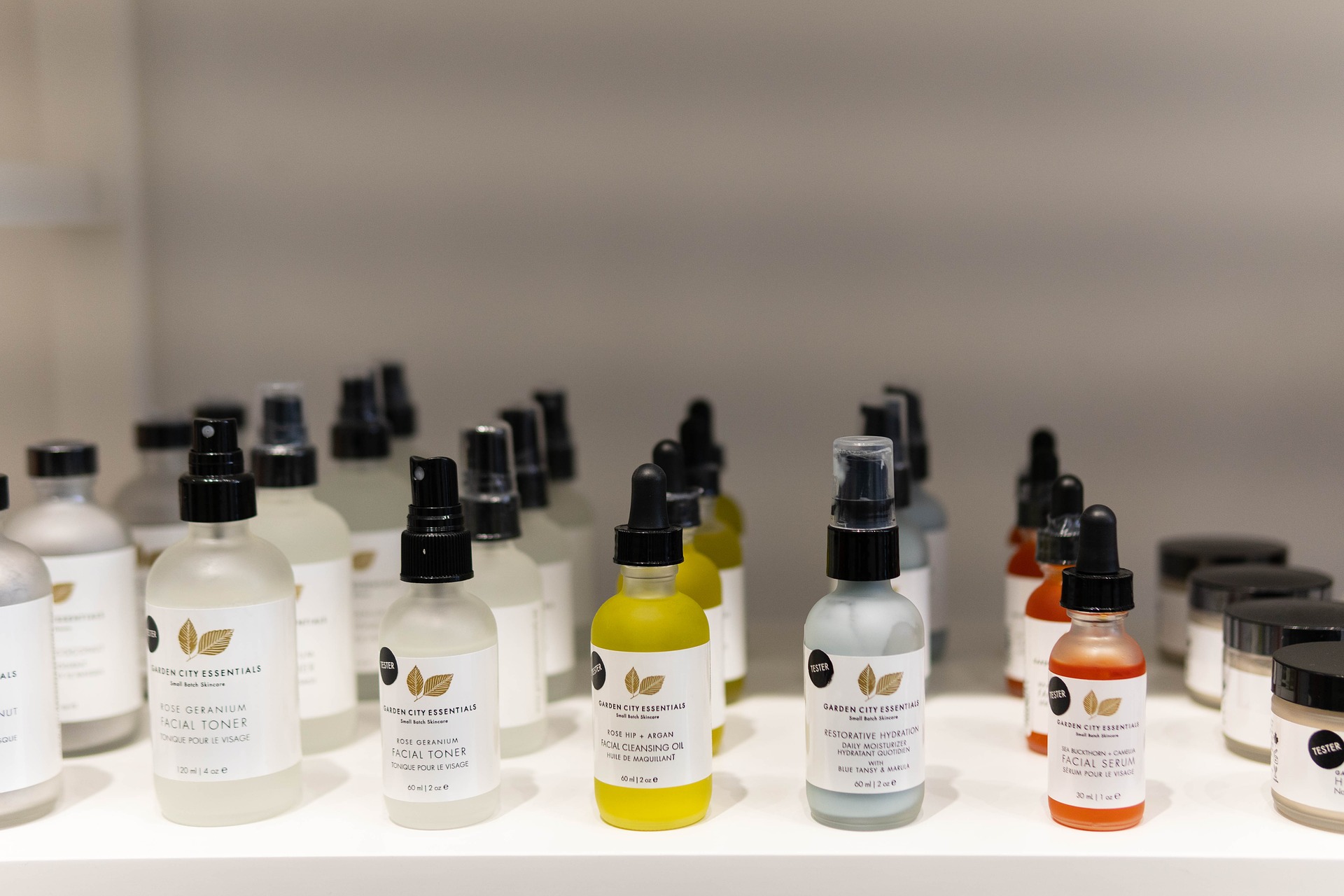
I get a daily feed of dozens of questions being asked by Quora.com subscribers that fall in the area of retirement, health and wellness, aging, and career transition.
I try to respond to one or two of those questions daily.
Most questions are worthy of attention, but every day produces some doozies. For example, here’s a sampling from the last couple of days:
By far, the most common question revolves around the topic of “anti-aging.”
I grind my teeth every time I see one.
Where do we get this idea that we can “anti-age?” Last I heard, we don’t come out of this thing alive.
Well, rather than grind, I decided to fire off a response to one and it seemed to kick up quite a few views. So I’ll share it with you.
Here was the question :
– and my response
Golly, folks – can we give “anti-aging” a rest??
Seriously, we’re making it way too easy for all these wonder cream and untested supplement manufacturers to laugh all the way to the bank.
May I quote Dr. Walter Bortz, retired Stanford geriatric physician from his book “Dare to Be 100”?
“Life is a fatal disease. Once contracted, there is no known cure.”
The rude, unassailable truth is that you and I are going to get wrinkly, creaky, and then die.
How ’bout we get rid of “anti-aging” – because it isn’t possible – and substitute it with something like “slower aging” or “decelerated aging.”
I know – really clunky.
Anti-aging is so easy and has a natural appeal even though it’s bunk, creating a hopeful image of something that isn’t possible.
We can’t stop the aging process – but we can slow its momentum.
Perhaps that’s a more reasonable, attainable goal. Given that we are going to grow old, let’s avoid GETTING OLD as long as possible.
OK, you can call it anti-aging or whatever you like, but I’m going to call it removing the accelerants of aging and suggest that you work toward eliminating those accelerants first.
Then maybe consideration of some of those wonder creams and supplements can come into play.
Let’s take a look at a dozen:
1. No exercise. I know, you’re tired of hearing it. And I know it’s likely you will buck it up at some point and renew that gym membership and just as likely you will fall off again six weeks later. It’s just not built into your lifestyle and it won’t sustain until you build it in. Think of it this way. Can you find 2.6% of your week that is going to unhealthy activities (TV, barstools, Facebook, etc.) and convert that to 45 minutes of combined aerobic and strength training six days of the week? That’s only 10% of the time the average American male spends each week watching TV (49 hours).
The potential ROI: living longer, dying shorter; more vitality longer; look better, feel better; amaze your overweight, sedentary, deteriorating friends; lower healthcare costs.
Perhaps this admonition from Dr. Henry Lodge in the book “Younger Next Year” will help:
“Aerobic exercise will give you life; strength-training will make it worth living.”
2. Diet heavy in animal products. Heart disease remains the number one killer in our culture. The link between heart disease and a diet heavy in animal products i.e. meat and dairy is indisputable despite all the claims to the contrary by those industries. A whole-food, plant-heavy diet brings with it a long list of benefits, only one of which is the reduced likelihood of heart disease. It also reduces the possibility of cancer, stroke, diabetes, and dementia which round out the rest of the top five killers in our culture.
3. Mindset. It’s amazing and disturbing to me how many of my generation are still of the mindset that senescence and frailty are automatic when we have so much evidence and knowledge to the contrary and many weapons against both.
Any personal move to add years to your life and life to your years has to start with a mindset that doesn’t accept this old thinking.
4. Healthcare illiteracy. We’ve allowed our personal healthcare to become a $35 co-pay experience with a physician who is entrenched in a disease-care system focused on cure and not on prevention. As such we put our self-care in a reactive mode versus a proactive mode. We think health only when something skids off the rails and then face a system that only knows drug it or cut it out.
One of the major keys to longevity is “self-efficacy” i.e. taking control of your own health destiny by understanding how your biology works, knowing where you stand against the key biomarkers of good health (see Key Step #2 in my free e-book Achieve_Your_Full-Life_Potential), and taking charge of your own health through increased knowledge and proactive action.
5. Conformity. Sir Walter Scott said he would trade whole years filled with mindless conformity for “one hour of life crowded to the full with glorious action, and filled with noble risks.”
When dying people in a hospice are asked about any regrets they had about their lives, by far the most common regret is “I wish I had pursued my dreams and aspirations, and not the life others expected of me.” ‘Nough said. Conformity involves comparison. Comparison is one of the biggest killers of happiness. Don’t believe that? Check out what Facebook is doing to our younger generations.
6. Suppressing courage. In the same hospice study, the second most common regret was “I wish I had the courage to express my feelings and speak my mind.” The author of the study, an Australian palliative care nurse by the name of Bronnie Ware learned that “many of her dying patients believed they suppressed their true feelings and didn’t speak their mind when they should have because they wanted to keep peace with others.”
Most of them chose not to confront difficult situations and people, even when it offended them. By suppressing their anger, they built up a lot of bitterness and resentment which ultimately affected their health. See the complete article here.
7. Toxic relationships. Jim Rohn, the renowned businessman and motivational speaker, famously said that “we are the average of the five people we spend the most time with.” Relationships with toxic people steal away life-giving energy while being around positive, encouraging, supportive people who are continuing to grow can restore energy. Choose your relationships wisely and dissolve those that are harmful.
8. Stopping learning. Historian Peter Laslett emphasizes that only by living into our natural lifespan are we able to exploit our true potential. As we age, our brain cells can become intimately connected with new and emerging realities. A lifelong strategy of learning is a potent force for good. Smart people live longer.
9. Isolation. According to the AARP Foundation, the health risk of prolonged isolation is equivalent to smoking 15 cigarettes a day. Research has shown a 26 percent increased risk of death due to the subjective feelings of loneliness.
10. Not working. Evidence has been in for a long time. Work is necessary for longer, healthier living. Polls of centenarians have revealed that an astonishingly high percentage of them continue to work and that they rank working alongside being able to walk as one of the keys to their longevity.
11. Narrowed comfort zones. As we age, we may tend to narrow our comfort zones. For example “I’ve never done that” or “I don’t know anything about computers” or “I’m too old to start that”. These responses are indicators that the fossilization process is underway. The fact that you hear 50-year olds making these statements is proof that “old” can start at any age. Source: The New Retirementality.
12. Traditional retirement. Going over the cliff from labor-to-leisure, vocation-to-vacation retirement can erode sense of purpose and identity. Without purpose, many of the life-shortening elements of retirement begin to creep in – boredom, increased isolation, declining social engagement, reduced physical activity, depression.
One in five of Americans over 65 suffer from some level of depression. Men aged 75 and older have the highest annual suicide rate of any group.
“Our ripples, the energy signature of our life, remain and endure. Rippling exalts Mozart, Buddha, Aristotle, Christ, Einstein, Darwin, to name a few, whose lives’ energies persist and penetrate today in a larger way than they did while alive. Similarly, even the most modest among us leaves ripples behind.”
“Once we confront our own mortality, we find it vastly easier to re-arrange our priorities, communicate more deeply with those we love, appreciate more keenly the beauty of life, and increase our willingness to take the risks necessary for personal fulfillment. And imprint our ripples on the cosmos forever.”
– how about more emphasis on our “ripples” and less on our “wrinkles?”
Mankind can use the help.
Can you add to this list? We’d love your feedback. Leave a comment below.

I knew an Opal in my hometown – 60+ years ago. Nice lady, as I recall. As were most ladies in my little hometown of 800.
I also knew a Doris – but he was my girlfriend’s father. Small towns come with some weirdness – but I digress.
Today, I met a different OPAL and I want to introduce her it to you.
This OPAL is Optimal Physical Activity for Longevity.
An article hit my Medium.com feed today entitled “How Much Exercise is Optimal for Longevity.” (see it here). The author, Gunter De Winter describes himself as “Biologist. Philosopher. Voracious consumer of ideas. Word wrangler & concept cuddler.”
I like the topic Gunter chose to “cuddle.” Any article with longevity in the title catches my eye since I’m still refusing to relinquish this nutty goal of living to 112 1/2. (I know, I know – snowball’s chance – – – -).
What if I don’t care about longevity?
I get it. A surprising percentage of people are repulsed by the idea of even living to 100. I sense I haven’t deepened any relationships amongst my closest cohort by declaring my outrageous goal. I’ve found it to be a marvelous tool to shorten a boring dinner engagement.
According to a research project done by Dr. Ken Dychtwald of the AgeWave organization and published in his recent book “What Retirees Want: A Holistic View of Life’s Third Age,” (affiliate link) only 22% of respondents said they want to live to 100 or beyond. Among those over 65 and older, twice as many said no (35%) as yes (17%).
If you are in the 78% or 35%, the rest of this will be painful, so an exit is totally understood. I appreciate that you clicked on.
There’s bad news – and then there’s bad news!
The first layer of bad news is that the public health guideline recommendation of at least 150–300 minutes of PA [physical activity] at moderate aerobic intensity or 75–150 minutes at vigorous intensity per week is woefully short of doing anything to enhance longevity. Much more engagement in PA is necessary to achieve maximal benefits on longevity. Cap that with the fact that less than 25% of the U.S. population even achieve this moderate intensity.
The second layer of bad news is that the O-P-A-L is a real butt-kicker that, based on the general attitude toward health and longevity in our culture, isn’t likely to get much of a nod, let alone an attempt.
Based on cohort studies, researchers suggest . . .
…maximal longevity gains at about 700 min of moderate or 350 min of vigorous PA per week.

700/7.
350/7
100 minutes/day; 50 minutes/day.
Even freakier if you felt you could maybe find 5 days in the week for O-P-A-L. Either is a stretch for all but the truly committed.
Don’t decisions get pretty basic with this type of information? As in back-to-back-to-back Ozark, Breaking Bad, and The Crown vs five extra years of healthy living?
Or two pops leading up to a meatloaf and gravy dinner.
Or selling out to the boss with an extra hour at the desk at the end of the day while your workout bag languishes in your car.
Or – well, you get the point.
As a culture (I’m talking mainly U.S. but also most western, supposedly “developed” cultures), we’re still given to “living too short and dying too long.’

We’re not very good at paying attention to the antidotes.
O-P-A-L is an antidote with a capital “A.”
I understand if longevity isn’t your thing. I understand the impressions that have been seated in your head of walkers, wheelchairs, oxygen bottles, needles, and nurses.
But what if you adopted O-P-A-L for another reason. Rather than more years in your life, put more life into the years you have.
The accelerating slope doesn’t have to be that severe. It could look more like this –
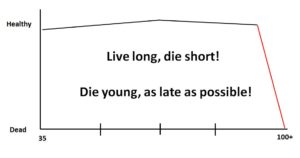
-with more life in your years.
Kinda, sorta.
If you’ve tracked with me for a while, you know I’m a fan and advocate of “Harry’s Rules”, the appendix in the book “Younger Next Year” (affiliate link) that was written by the co-author, the late Dr. Henry Lodge.
Here’s a refresher in case you haven’t yet invested in the book:
Harry’s Rules
Exercise six days a week for the rest of your life.
Do serious aerobic exercise four days a week for the rest of your life.
Do serious strength training, with weights, two days a week for the rest of your life.
Spend less than you make.
Quit eating crap!
Care.
Connect and commit.
I’ve been coming pretty darn close to Dr. Lodge’s rules for the last 10-12 years. The pandemic screwed that up for a while, but I’m back on track at 24-Hour Fitness 3 days a week for 90-minute sessions that include aggressive strength training (alternating between free weights and machines and working all the muscle groups across the week) plus 30 minutes of aerobic exercise. I supplement the rest of the week with aerobic (walking, treadmill, elliptical) for 30 minutes (on a good day).
Yep, falling a bit short of the O-P-A-L total, but, c-mon, not bad for a guy just 5 months short of stepping into his 9th decade.
Can I get to O-P-A-L? Sure. It’s just attitude and a decision.
Yeah, falling a bit short because that’s a tough list. But we all have a list of things to overcome.
Sorry, dear reader, but anything even close to O-P-A-L ain’t gonna happen unless it’s in writing on your calendar and seated firmly into your habit patterns.
As James Clear reminds us in his runaway best-selling and life-changing book “Atomic Habits”:
“The punch line is clear: people who make a specific plan for when and where they will perform a new habit are more likely to follow through. Too many people try to change their habits without these basic details figured out. Many people think they lack motivation when what they really lack is clarity.”
Albeit tough, O-P-A-L makes it clear.
It helps to remember that nothing significant happens in the comfort zone.
Does anyone out there come close to O-P-A-L? What’s your routine? What’s working best for you? I’d love to have you share your method with the tribe. Leave a comment below. Thanks for reading. If you haven’t joined our group, jump on my email list at www.makeagingwork.com to receive my weekly post. I’ll send you a free ebook entitled “Achieving Your Full-life Potential.”

Image by Arek Socha from Pixabay
Who doesn’t want to be relevant, germane, material, applicable, apropos?
It’s an important question if one is choosing to play the retirement game.
My first suggestion in answer to the question is to be sure you approach retirement with a plan that goes beyond the money. Most individuals and couples step into retirement without a non-financial plan for what they would like their retirement years to look like. They mistakenly believe that retirement will take care of itself when, in fact, there are always hidden surprises.
Much like the Titanic discovered when negotiating icebergs.

The question of relevance is important because it is one of the top four fears that pre-and early-retirees have about retirement beyond money.
All of these concerns are addressable. Yet, most people drift into their retirement without a plan designed to deal with them. Items #1–#3 are intertwined and together they have a significant impact on #4.
The question of relevance is a very individual thing. Ultimately, we define our own relevance by the way we view things and the way we are wired up. One new retiree may find his or her relevance in the dedication to and interaction with grandchildren. The next may only feel relevant only if he or she is continuing to drive big decisions or be building something.
A quick look at the definition of relevance tells us it is “bearing on the matter at hand, practical, and especially social applicability.” This brings to bear the importance of retiring into something, not just from something. In other words, what will be your “matter at hand” upon retiring?
In my experience as a career transition and retirement coach dealing mostly with healthcare professionals, I have found a surprising number of these talented professionals looking forward to retirement but unable to articulate what they expect, or want, to do upon retirement. They do express concern about going from 110 miles an hour, 50 hours a week down to near zero.
But, for most, the “what’s next” is fuzzy.
My suggestion to those who are struggling in this area is to start planning for retirement at least 3–5 years in advance of the anticipated retirement date and start putting things on paper.
And, if you are a couple, communicate, communicate, communicate!
Early – and often!
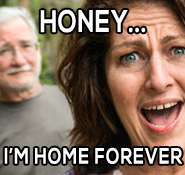
Remember, fellas, she married you for better or worse but not for lunch every day. Kitchen drawer arrangements are off-limits and she is not your “retirement plaything.” In fact, that may be the farthest thing from her mind. With “grey divorce” i.e. divorces amongst couples over 50 skyrocketing, maybe we should be paying attention to communication early and often.
Practice may not always make perfect but some retirement practice can go a long way.
Successful retirees often include some “practice retirement” by experimenting with some activities that they think they may have an interest in post-career. That may come in the form of a sabbatical from work, or using accumulated vacation and PTO time to immerse into something on the curiosity list. Maybe a short-term apprenticeship in a business or volunteer opportunity to test it out.
Practice can be particularly important when it comes to location decisions. That practice can include living for a period in an area that is being considered for relocation, or for a second home. I’ve heard more than one story of regret of making a move only to discover the “personality” of the area was a bad match.

There certainly is some excitement in being a risk-taker and jumping into something without a plan and let the chips fall where they may.
I suggest retirement isn’t one of those things. This is a potential 20-, 30-, 40-year experience with serious long-term implications. Front end planning can have a significant impact on health, longevity, and family stability.
I’ve heard of new retirees taking a transition year to travel, experiment, unwind, and develop a plan to follow for the balance of their retirement year. If finances permit, it’s a great transition plan.
My sense is that relevance will be found in living a life of service. We do know, from extensive research, that some form of work is vital to maintaining vitality and a sense of purpose through our retirement years, not to mention contributing to greater longevity. That flies in the face of the traditional leisure-based, consumer-only type retirement that we’ve been pedaled for the last 5–6 decades.
Happier, healthier retirees have something that motivates them to get up in the morning and that provides them a sense of relevance. The nice thing about retirement is that you now have the time and resources (hopefully) to be able to find that relevance, knowing that it may change through your retirement.
Be flexible and don’t let your relevance be dictated by the opinions of others. Be your own person and honor your inner self. It will ultimately let you know what is relevant for your life.
I had to wait until my seventies to make that discovery. I wish for you an earlier and easier discovery. Hence, start early.
Know your drivers.
I had the good fortune to share some of this pre-retirement planning insight in a workshop recently with a group of six successful Canadian entrepreneurs who have been meeting together as a sort of “mastermind” group for 15 years. Ranging in age from 57 to 64, they were at various stages of transition, with their businesses and their lives.
Their interest was in this very question: What’s next and how do we best plan for it?
One of the members expressed his fear of FOMO – fear of missing out on what this next phase could be. They all had a similar uneasiness about how to plan for this next phase which contained big decisions such as succession planning with family members and sell-or-stay decisions.
None of the six had financial concerns -their business prowess had taken care of that. Yet, even with day-to-day big decision ability, this question loomed large.
We covered a lot of ground over a two-day, four-hour Zoom workshop with six different topics. One of those topics was a “driver identification” exercise drawing from the content provided in the book “Don’t Retire, REWIRE! “ They were asked to identify their five strongest drivers from a list of 30 provided in the book. Drivers are described as what makes you tick as a human being because they go deep inside you, to your brain, heart, and ego. I asked them to reflect on how they have applied those drivers in their business, and then, more importantly, how they can carry those drivers forward into the retirement phase of their lives. The exercise essentially identified their “core” – a core that doesn’t go away with retirement.
That proved to be the strongest take-away from our time together with them coming away considering how they can continue to apply those drivers but during this next life phase.
No quick answers there, but it moved the needle in setting the table for deeper reflection, more and deeper communication across the family spectrum, and, hopefully, a clearer definition of how those drivers can continue to be deployed in a different type of service.
I strongly recommend the book if you are at this critical juncture.
Follow your heart
The other story came from a Quora writer, Forrest Held, who answered the same question. Here’s his answer:
Relevant in retirement is different than relevant in a career.
Get over it.
You miss the ego-boosting feedback.
You miss the pressure of producing on a schedule.
No one is seeking your input for weighty decisions.
That doesn’t mean you are irrelevant. You will find you are relevant to others and in other ways. New people need you. At retirement age, family and friends will need your help.
My first two years of retirement were spent taking care of my father in the latter stages of dementia. He didn’t know who I was, and he was in a facility. I spent my time making sure he was safe and well cared for each day. I took care of the estate and liquidated assets to pay for his care.
In his last year, I was known as the guy who would take him out to get ice cream. Like his father, it was his favorite treat. He had no real idea who I was.
I am glad I was there in the last years of his life taking care of him like he took care of me when I was young.
After my father passed, I volunteered for hospice with the company that had helped him. I learned a lot about life and death in that year. Suddenly those meetings and schedules seemed less critical. People who know they are dying have a way of sifting through all the crap.
You need to adjust to your new life.
Don’t relive the past.
Live for the future.
Take on new challenges.
Do things outside your comfort zone.
Enjoy time with your loved ones.
Reconnect with people you liked but have been missing from your life over the past three decades.
Say thank you more often. Be grateful that you have lived this long. Make the world a better place through your wisdom.
If you open your eyes and arms to the opportunities, you will find you are more relevant. Your relevance will be in areas that are more important than those you had during your career.
I don’t know where Forrest has ended up in his retired life, but I would guess that it doesn’t fit the off-the-cliff, labor-to-leisure, vocation-to-vacation model. And the world is better for his view of relevance.
If you’re retired, how are you finding relevance? We’d love to hear your story. Leave a comment below or email me at gary@makeagingwork.com.
If you have any comments or questions, please click here and you will be taken to our contact page.
Our support Hotline is available 24 Hours a day: (555) 343 456 7891

